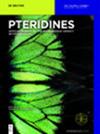疟媒斯氏按蚊中蝶啶的年龄依赖性
IF 0.9
4区 医学
Q4 BIOCHEMISTRY & MOLECULAR BIOLOGY
引用次数: 1
摘要
摘要确定疟疾媒介的准确年龄对于衡量疟疾传播风险至关重要。从成年雌性斯氏按蚊的头部、胸部和全身提取了一组由嘧啶-吡嗪环结构(即蝶呤)衍生的荧光化学物质,并对其进行了鉴定和评估,作为确定疟疾媒介生物年龄和生理年龄的工具。每隔5天,最多30天从昆虫群落中采集雌性蚊子,并通过高压液相色谱法(HPLC)分别使用365和455nm的激发和发射波长,用荧光法检测头部、胸部和全身的翼点。此外,还比较了血液和食糖蚊子组中蝶呤类化合物的变化。虽然检测到四种蕨类植物,包括蝶呤-6-羧酸、生物蝶呤、黄蝶呤和异黄蝶呤,但其中一些在蚊子的头部或胸部不存在。在整个30天内,所有四种蕨类植物的水平都以类似的线性方式降低。在血液或糖喂养的两组蚊子之间,没有观察到蝶呤化合物的变化有显著差异。这一结果表明,饮食对蕨类植物的改变影响不大。基于蝶呤的年龄测定作为一种年龄分级技术,可以用于野外采集的有糖或血粉的蚊子。此外,仅从全身分析总蝶呤荧光可能是估计年龄的一种方便的方法。本文章由计算机程序翻译,如有差异,请以英文原文为准。
Age-dependance of pteridines in the malaria vector, Anopheles stephensi
Abstract Determining the accurate age of malaria vectors is crucial to measure the risk of malaria transmission. A group of fluorescent chemicals derived from a pyrimidine-pyrazine ring structure known as pteridines from the head, thorax and whole body of adult female Anopheles stephensi were identified and evaluated as a tool for chronological and physiological age determination of malaria vectors. The female mosquitoes were collected from an insectary colony at an interval of every 5 days, up to 30 days, and the pteridines of head, thorax and whole body were detected fluorometrically by high-pressure liquid chromatography (HPLC) using excitation and emission wavelengths of 365 and 455 nm, respectively. In addition, alteration of the pteridines compounds was compared between blood and sugar fed mosquito groups. Although four pteridines including pterin-6-carboxylic acid, biopterin, xanthopterin and isoxanthopterin were detected, some of them were absent in the head or thorax of mosquitoes. Levels of all four pteridines were similarly decreased in a linear manner throughout 30 days. No significant difference in alteration of pteridine compounds was observed between the two groups of blood or sugar fed mosquitoes. This result indicates that diet has a little effect on pteridines alteration. Age determination based on pteridines, as an age-grading technique, could be used for field collected mosquitoes, which have either sugar or blood meal. In addition, analyzing total pteridine fluorescence from only whole body could be a convenient method to estimate the age.
求助全文
通过发布文献求助,成功后即可免费获取论文全文。
去求助
来源期刊

Pteridines
生物-生化与分子生物学
CiteScore
1.20
自引率
25.00%
发文量
6
审稿时长
>12 weeks
期刊介绍:
Pteridines is an open acess international quarterly journal dealing with all aspects of pteridine research. Pteridines are heterocyclic fused ring compounds involved in a wide range of biological functions from the color on butterfly wings to cofactors in enzyme catalysis to essential vitamins. Of the pteridines, 5,6,7,8-tetrahydrobiopterin is the necessary cofactor of several aromatic amino acid monoxygenases, the nitric oxide synthases and glyceryl ether monoxygenase (GEMO). Neopterin plays an essential role in the immune system and is an important biomarker in laboratory medicine for diseases such as HIV, cardiovascular disease, malignant tumors, among others.
Topics:
-Neopterin, dihydroneopterin, monapterin-
Biopterin, tetrahydrobiopterin-
Folates, antifolates, riboflavin-
Phenylalanine, tyrosine, phenylketonuria, serotonin, adrenalin, noradrenalin, L-DOPA, dopamine, related biogenic amines-
Phenylalanine hydroxylase, tyrosine hydroxylase, tryptophan hydroxylase, nitric oxide synthases (iNOS), alkylglycerol monooxygenase (AGMO), dihydropterin reductase, sepiapterin reductase-
Homocysteine, mediators of inflammation, redox systems, iron.
 求助内容:
求助内容: 应助结果提醒方式:
应助结果提醒方式:


